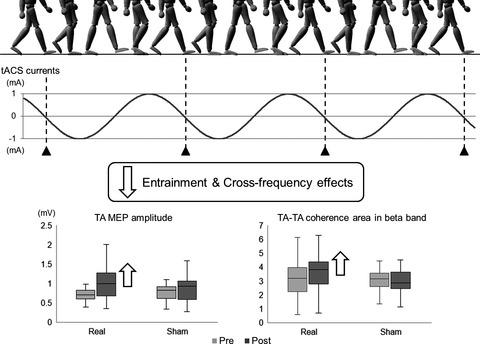当前位置:
X-MOL 学术
›
Eur. J. Neurosci.
›
论文详情
Our official English website, www.x-mol.net, welcomes your
feedback! (Note: you will need to create a separate account there.)
Gait-combined transcranial alternating current stimulation modulates cortical control of muscle activities during gait.
European Journal of Neuroscience ( IF 2.7 ) Pub Date : 2020-07-29 , DOI: 10.1111/ejn.14919 Ryosuke Kitatani 1, 2 , Satoko Koganemaru 3 , Ayaka Maeda 1 , Yusuke Mikami 4 , Masao Matsuhashi 5 , Tatsuya Mima 6 , Shigehito Yamada 1
European Journal of Neuroscience ( IF 2.7 ) Pub Date : 2020-07-29 , DOI: 10.1111/ejn.14919 Ryosuke Kitatani 1, 2 , Satoko Koganemaru 3 , Ayaka Maeda 1 , Yusuke Mikami 4 , Masao Matsuhashi 5 , Tatsuya Mima 6 , Shigehito Yamada 1
Affiliation

|
Non‐invasive brain stimulation has been of interest as a therapeutic tool to modulate cortical excitability. However, there is little evidence that oscillatory brain stimulation can modulate the cortical control of muscle activities during gait, which can be assessed using coherence analysis of paired surface electromyographic (EMG) recordings. This study aimed to investigate the effects of gait‐combined transcranial alternating current stimulation (tACS) at the gait cycle frequency on the cortical control of muscle activities during gait using EMG‐EMG coherence analysis. Fourteen healthy young adults participated in this study. All participants underwent 2 test conditions (real tACS and sham stimulation over the leg area of the primary motor cortex during 10‐min treadmill walking). The average peak‐to‐peak amplitudes of the motor evoked potentials (MEPs) from the tibialis anterior (TA) and lateral gastrocnemius muscles in the sitting position and EMG‐EMG coherences in the TA muscle, triceps surae muscles, quadriceps muscles, and hamstring muscles during gait were measured before and after stimulation. Entrainment effect was significantly higher during real tACS than during sham stimulation. After real tACS, the MEP amplitude and beta band (13–33 Hz) coherence area increased in the TA muscle. The change in MEP amplitude from the TA muscle was positively correlated with the change in beta band coherence area in the TA muscle. Gait‐combined tACS can modulate the strength of descending neural drive to TA motoneurons during gait. This suggests that oscillatory brain stimulation is a useful therapeutic tool to modulate the cortical control of muscle activities during gait.
中文翻译:

步态结合的经颅交流电刺激在步态中调节皮质对肌肉活动的控制。
作为调节皮层兴奋性的治疗工具,无创性脑刺激已经引起人们的兴趣。然而,几乎没有证据表明振荡性脑刺激可以在步态中调节皮质对肌肉活动的控制,这可以使用成对表面肌电图(EMG)记录的相干分析来评估。这项研究旨在使用EMG-EMG相干分析研究步态联合经颅交流电(tACS)在步态周期频率对步态过程中肌肉活动的皮质控制的影响。十四名健康的年轻人参加了这项研究。所有参与者都经历了两种测试条件(在跑步机行走10分钟的过程中,对主要运动皮层的腿部区域进行了真实的tACS和假刺激)。坐位时胫骨前肌(TA)和腓肠肌外侧的运动诱发电位(MEP)的平均峰-峰幅度以及TA肌肉,肱三头肌,肱四头肌和E绳肌的EMG-EMG相干性在刺激之前和之后测量步态期间的肌肉。真正的tACS期间的夹带作用明显高于假刺激。真正的tACS后,TA肌肉中的MEP振幅和β带(13–33 Hz)相干面积增加。TA肌肉中MEP振幅的变化与TA肌肉中β带相干区域的变化呈正相关。步态组合的tACS可以在步态中调节神经运动对TA运动神经元的下降强度。
更新日期:2020-07-29
中文翻译:

步态结合的经颅交流电刺激在步态中调节皮质对肌肉活动的控制。
作为调节皮层兴奋性的治疗工具,无创性脑刺激已经引起人们的兴趣。然而,几乎没有证据表明振荡性脑刺激可以在步态中调节皮质对肌肉活动的控制,这可以使用成对表面肌电图(EMG)记录的相干分析来评估。这项研究旨在使用EMG-EMG相干分析研究步态联合经颅交流电(tACS)在步态周期频率对步态过程中肌肉活动的皮质控制的影响。十四名健康的年轻人参加了这项研究。所有参与者都经历了两种测试条件(在跑步机行走10分钟的过程中,对主要运动皮层的腿部区域进行了真实的tACS和假刺激)。坐位时胫骨前肌(TA)和腓肠肌外侧的运动诱发电位(MEP)的平均峰-峰幅度以及TA肌肉,肱三头肌,肱四头肌和E绳肌的EMG-EMG相干性在刺激之前和之后测量步态期间的肌肉。真正的tACS期间的夹带作用明显高于假刺激。真正的tACS后,TA肌肉中的MEP振幅和β带(13–33 Hz)相干面积增加。TA肌肉中MEP振幅的变化与TA肌肉中β带相干区域的变化呈正相关。步态组合的tACS可以在步态中调节神经运动对TA运动神经元的下降强度。











































 京公网安备 11010802027423号
京公网安备 11010802027423号